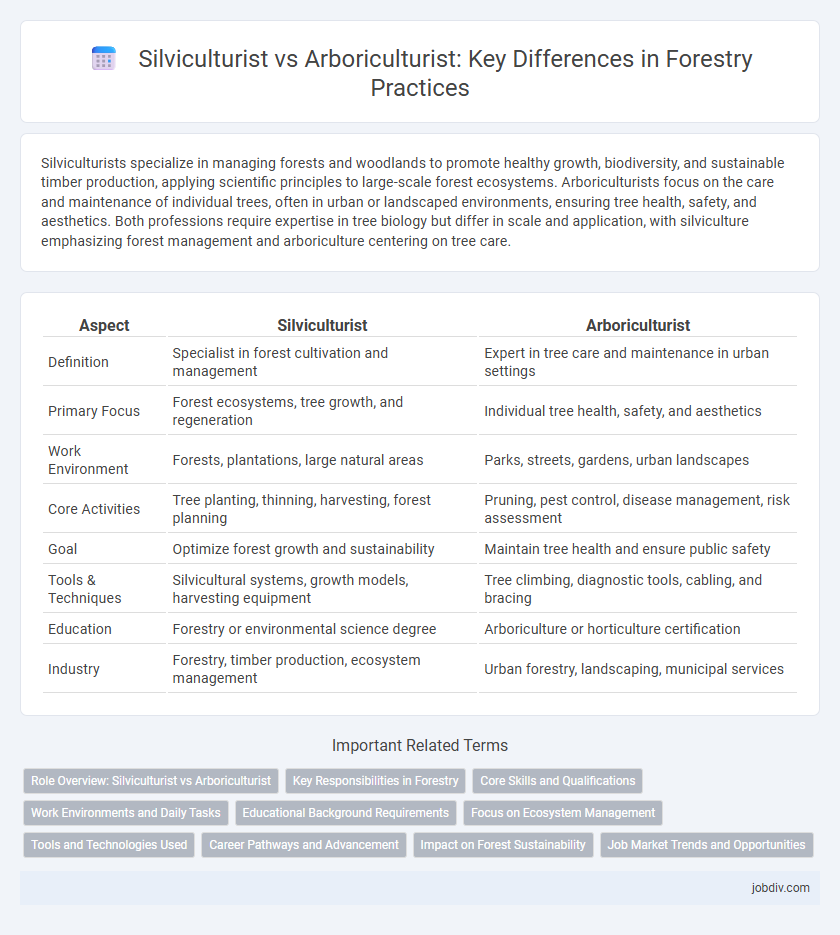Silviculturists specialize in managing forests and woodlands to promote healthy growth, biodiversity, and sustainable timber production, applying scientific principles to large-scale forest ecosystems. Arboriculturists focus on the care and maintenance of individual trees, often in urban or landscaped environments, ensuring tree health, safety, and aesthetics. Both professions require expertise in tree biology but differ in scale and application, with silviculture emphasizing forest management and arboriculture centering on tree care.
Table of Comparison
| Aspect | Silviculturist | Arboriculturist |
|---|---|---|
| Definition | Specialist in forest cultivation and management | Expert in tree care and maintenance in urban settings |
| Primary Focus | Forest ecosystems, tree growth, and regeneration | Individual tree health, safety, and aesthetics |
| Work Environment | Forests, plantations, large natural areas | Parks, streets, gardens, urban landscapes |
| Core Activities | Tree planting, thinning, harvesting, forest planning | Pruning, pest control, disease management, risk assessment |
| Goal | Optimize forest growth and sustainability | Maintain tree health and ensure public safety |
| Tools & Techniques | Silvicultural systems, growth models, harvesting equipment | Tree climbing, diagnostic tools, cabling, and bracing |
| Education | Forestry or environmental science degree | Arboriculture or horticulture certification |
| Industry | Forestry, timber production, ecosystem management | Urban forestry, landscaping, municipal services |
Role Overview: Silviculturist vs Arboriculturist
Silviculturists manage forest ecosystems focusing on the growth, composition, and health of forests for timber production, biodiversity, and sustainability. Arboriculturists specialize in the care and maintenance of individual trees in urban or landscaped environments, addressing tree health, safety, and aesthetics. Both professions require extensive knowledge of tree biology but apply their expertise in distinctly different contexts and scales.
Key Responsibilities in Forestry
Silviculturists manage forest ecosystems by implementing sustainable practices such as planting, thinning, and harvesting to ensure forest health and timber production. Arboriculturists specialize in the care and maintenance of individual trees in urban and suburban environments, focusing on tree health, safety, and aesthetics. Both roles contribute to forestry, but silviculturists address large-scale forest management while arboriculturists concentrate on tree care in developed landscapes.
Core Skills and Qualifications
Silviculturists specialize in forest management, requiring expertise in ecology, silviculture techniques, and forest regeneration to promote sustainable timber production. Arboriculturists focus on the care and maintenance of individual trees, emphasizing skills in tree biology, pruning, pest management, and risk assessment. Both professions typically require a degree in forestry, environmental science, or horticulture, but arboriculturists often pursue specialized certifications like ISA Certified Arborist, while silviculturists may engage in advanced studies related to forest ecology and management.
Work Environments and Daily Tasks
Silviculturists primarily work in forested landscapes, managing large-scale ecosystems to promote sustainable timber production, biodiversity, and forest health through activities like planting, thinning, and controlled burns. Arboriculturists focus on individual trees in urban, suburban, and park settings, specializing in tree care, disease management, pruning, and risk assessment to maintain tree health and safety. While silviculturists plan and implement forest management at a broad scale, arboriculturists provide hands-on care and maintenance for trees in human-populated environments.
Educational Background Requirements
Silviculturists typically require a degree in forestry, environmental science, or natural resource management, emphasizing forest ecology, soil science, and tree physiology. Arboriculturists often hold qualifications in horticulture, arboriculture, or urban forestry, focusing on tree care, pruning techniques, and pest management. Both professions demand knowledge of tree biology but differ in their specialized educational tracks tailored to forest ecosystems versus individual tree care in urban environments.
Focus on Ecosystem Management
Silviculturists specialize in managing forest ecosystems to promote sustainable timber production, biodiversity, and soil health through techniques like thinning, controlled burns, and regeneration practices. Arboriculturists focus on the care and maintenance of individual trees within urban and peri-urban environments, enhancing tree health, safety, and aesthetic value while supporting urban ecosystem services. Both disciplines contribute to ecosystem management, with silviculture addressing large-scale forest dynamics and arboriculture emphasizing the resilience and functionality of trees in human-dominated landscapes.
Tools and Technologies Used
Silviculturists employ advanced remote sensing technologies, GIS mapping, and forest inventory software to monitor tree growth and manage forest ecosystems efficiently. Arboriculturists utilize tools such as aerial lifts, precision pruning equipment, and tree health diagnostic devices like resistographs to maintain and care for individual trees in urban and landscaped environments. Both professionals integrate drone technology and data analytics to enhance decision-making processes in forestry management and tree care.
Career Pathways and Advancement
Silviculturists primarily advance through roles in forest management, research, and conservation, often requiring expertise in ecosystem dynamics and sustainable timber production. Arboriculturists focus on urban tree care, progressing toward positions in municipal planning, tree risk assessment, and urban landscape design with specialized knowledge in tree physiology and pest management. Both career paths benefit from certifications like ISA Certified Arborist for arboriculturists and Registered Professional Forester (RPF) for silviculturists, enhancing opportunities for leadership and consultancy roles.
Impact on Forest Sustainability
Silviculturists manage forest ecosystems by implementing practices that promote long-term timber production, biodiversity, and soil health, directly enhancing forest sustainability. Arboriculturists focus on the care and maintenance of individual trees in urban and suburban settings, improving tree longevity and urban green space resilience. The combined efforts of both professions contribute to balanced forest management and sustainable environmental stewardship.
Job Market Trends and Opportunities
The job market for silviculturists is expanding due to increasing demand for sustainable forest management and reforestation projects, particularly in regions prioritizing climate change mitigation. Arboriculturists see growing opportunities in urban forestry and tree health management, driven by city planning initiatives and rising awareness of green infrastructure benefits. Both professions benefit from advancements in technology and increased funding for environmental conservation programs, shaping their dynamic career landscapes.
Silviculturist vs Arboriculturist Infographic

 jobdiv.com
jobdiv.com